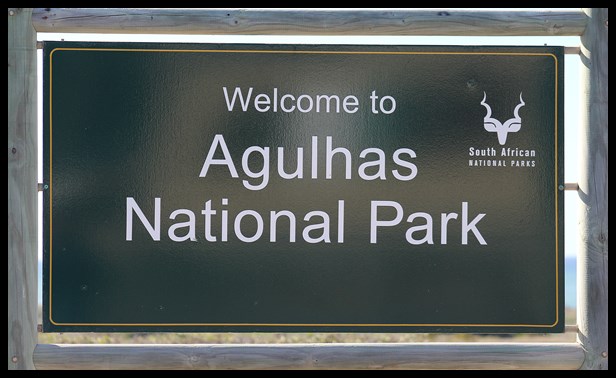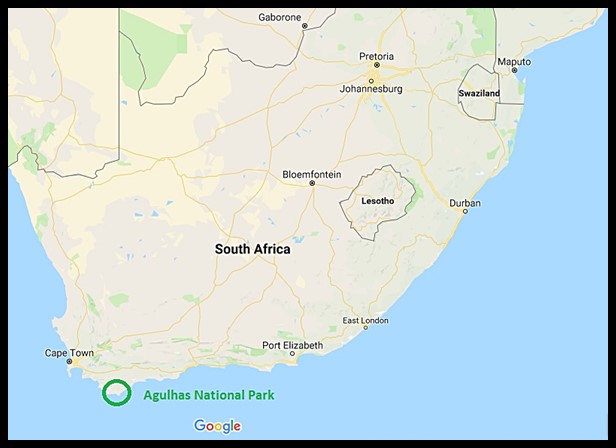
Fifteenth century Portuguese seafarers named Cape Agulhas when they found that magnetic compass needles pointed precisely true north here (“agulhas” being Portuguese for “needles”). It is also the southern-most point of the African mainland, where the Atlantic and Indian Oceans meet, and has been inhabited by humans for over a million years with several sites of archaeological interest. The Agulhas Plain also has an incredible biodiversity and it was realised that what remained of it was worthy of protection, leading to the proclamation of the Agulhas National Park in 1999. Today the park covers almost 230km².
This is one of the world’s most treacherous coastlines. Since 1552, at least 125 ships met their fate around Cape Agulhas. For this reason the lighthouse at Cape Agulhas was commissioned in 1849, and is the second oldest of the 56 working lighthouses along our coast. It was designed as a replica of the Pharos of Alexandria, one of the seven wonders of the ancient world, and at night its beam can be seen up to 60km offshore. One of the most easily seen wrecks is that of the Meishu Maru, a Japanese fishing vessel with a cargo of 240t of tuna, that ran aground in 1982, happily without any loss among the 17 crew members. Today, a fascinating museum and information centre is housed inside the lighthouse.
The vegetation of the Agulhas National Park consists mainly of fynbos, with an estimated 2,000 plant species finding protection within its borders, many of which are rare and occur nowhere else on earth. The vegetation doesn’t grow very tall here due to the extremely windy conditions that prevail throughout the year. The area is rather flat and featureless, with rocky and sandy beaches alternating and stretching for many kilometers. And the sunsets from the main camp, as the sun dips into the Atlantic Ocean (the camp lies west of the southernmost tip of Africa) is a sight to behold!
The Park is still being developed, and as such does not yet contain large terrestrial mammals in any significant numbers. Most of the mammal species that occur here are either marine or small and rarely seen. The Agulhas National Park is however a prime birding spot, both for land and sea birds.
Guests can overnight in the main rest camp, which consists of one or two bedroom cottages and the luxury Lagoon House, built right on the rocks at the ocean’s edge. A few historic farm houses spread throughout the inland portions of the Park has also been renovated to accommodate guests. An extensive network of walking trails have been laid on around the main camp. All modern services and amenities associated with small holiday towns can be found in nearby L’Agulhas and Struisbaai. The nearest big town is Bredasdorp, 35km to the north.
The Agulhas National Park is located about 250km southeast of Cape Town, with the main rest camp a short drive from the small holiday town of L’Agulhas. It was the third destination on our December holiday tour of eight of our country’s national parks.




































A lighthouse keeper or automated?
LikeLike
It has been automated, Alanna
LikeLike
Wanneer hoor ons van die blogtoekennings? Is ek deurmekaar?
LikeLiked by 1 person
As ek reg onthou eers weer einde van hierdie maand of vroeg volgende maand, Tina.
LikeLiked by 1 person
Well, your account of the compass pointing true north is exciting. Portugese were diligent folk, wouldn’t you say. They have had quite a presence in India too–especially the west coast area.
BTW, I have managed to get back into my Muliebral Studies blog and even changed the gravatar/avatar. Now I really need help to do the same for my Muliebral Viewpoint blog too.
LikeLike
I hope the techies get you back up and running soon, Beth!
LikeLiked by 1 person
Stunning photos guys. This post takes me back to my primary school history lessons that I loved.
LikeLiked by 1 person
Then the museum at the Agulhas Lighthouse will be just up your alley, Kim!
LikeLiked by 1 person
It is. I have been there.
LikeLiked by 1 person
Your piece has enticed me to visit – I shall look into it…
LikeLiked by 1 person
You’ll not be sorry, Debbie. Agulhas has certainly stolen our hearts – we only wish we didn’t stay so far away!
LikeLiked by 2 people
En hierdie lighuis is mos Toortsie se kenmerk. 😁
LikeLiked by 1 person
Daar is iets baie spesiaal aan Agulhas se ligtoring, Toortsie!
LikeLiked by 1 person
Ons is baie lief vir ons lighuis. 😁
LikeLiked by 1 person
En met goeie reg – die geskiedenis en die simboliek trek mens in!
LikeLiked by 1 person
It´s an amazing place.😊 Wonderful pictures as usual. Many beautiful birds, and the wreck is so cool.😊
LikeLike
The wreck of the Meishu Maru really lends a “spooky” atmosphere to that part of the coast!
LikeLiked by 1 person
What a place that would be to explore!
LikeLike
It was our first visit to Agulhas, and we certainly left there with a sense that we still haven’t seen nearly enough of it!
LikeLiked by 1 person
Goodness, that is a lot of ships to have met their fate.
LikeLike
Africa’s southernmost tip is a treacherous place for ships – thank goodness for the lighthouse!
LikeLike